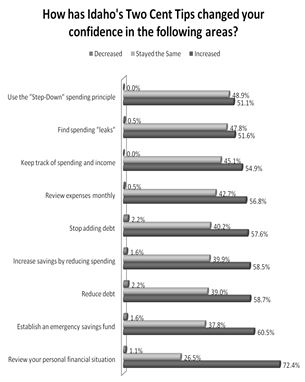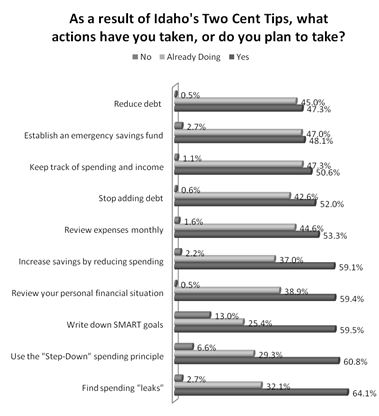 |
December 2012
|
December 2012 // Volume 50 // Number 6 // Tools of the Trade // v50-6tt5
E-Newsletters: A Simple Way to Integrate Technology with Extension Programming
Abstract
Extension educators can easily include technology in regular programming. Several Extension faculty conducted a survey to determine the overall effectiveness of a electronic newsletter (e-newsletter). Results indicated that this e-newsletter had a wide viral reach, provided strong local impact in terms of confidence and behavior changes, increased website traffic, and helped establish a strong web presence. This e-newsletter also helped increase programming requests and strengthen relationships with local legislators and other leaders. The implication is that e-newsletters are cost-effective, time-friendly, and relatively non-technical tools for expanding the reach of local Extension programs, and for reaching online audiences.
Introduction
Creating an Internet presence can be an important factor in establishing a trusted identity in a community (Oleson, 2004). Emailing an electronic newsletter (e-newsletter) is a way for Extension educators to be more reactive, efficient, and timely in meeting clientele needs (Siegrist, Labarge, & Prochaska, 1998).
Email is an inexpensive way to share timely articles, keep in touch with clientele, and increase Web traffic to Extension-sponsored websites or social media sites like Facebook and YouTube (Martinson, Wieland, & Bartholomay, 2010; Botherson & Bouwhuis, 2007; Forstadt, 2011).
Online newsletters have nearly unlimited distribution potential because little effort is required to share a newsletter from friend to friend. Online newsletters can also be archived and thus remain accessible for months and even years after the original publication date. All these features make e-newsletters very effective at establishing a strong web presence (Garry, 2009).
Certain audiences still prefer a traditional printed copy of a newsletter or simply lack Internet access (Coffin, 2007; Forstadt, 2011). However, online newsletters can easily be produced in a printable format, making traditional and online distribution a simultaneous effort.
Objectives
This article shares the results of a survey that attempted to measure the overall impact of a financial e-newsletter called Idaho's Two Cent Tips. Specifically, the objectives of the survey were to measure the overall effectiveness of the e-newsletter; knowledge gained; actions taken; viral activity (numerical totals of shared and forwarded newsletters and newsletter content); and other open-ended feedback.
Method
After over 2 years of monthly newsletter publication, two county Extension educators in Idaho developed an online survey using the popular survey website, surveymonkey.com. A direct link to this survey was distributed to an estimated 1,500 subscribers, along with the regular monthly edition of the newsletter. Two follow-up reminders were also sent to subscribers, producing n= 186 responses to the survey, a 12.4% response rate. While this response rate is admittedly low when compared to traditional Extension programming efforts, the findings are still very useful for illustrating potential impact of simple efforts to integrate technology with Extension programming. No incentives were used to gain survey responses.
Findings
Of 186 respondents, 96.7% reported that the educational articles in the newsletter were either helpful or very helpful, and 99% reported that the overall newsletter was either helpful or very helpful. Additionally, changes in confidence and behavior are reported in Figures 1 and 2.
Figure 1.
Change in Confidence

Figure 2.
Change in Actions

One of the most unexpected results from the survey was the impact of informal partnerships, also known as viral activity, of the newsletter. This refers to the number non-subscribers who received the newsletter indirectly from friends or associates. Of the 186 respondents, approximately 70% reported sharing the newsletter or content from the newsletter with others.
The question read, "With approximately how many people do you share or forward Idaho's Two Cents Tips, per issue?"
Selected responses concerning friends, family and coworkers:
- "Five and will add my family of seven."
- "I print it and put it in the faculty room at my school."
- "20 office volunteers."
- "Our staff of 35."
Selected comments from leaders, advisors, and educators:
- "About 10-20 clients each month."
- "Mail with [our] county newsletter."
- "[I] share [it] with two budget and buying classes."
Selected comments from media outlets:
- "I have utilized information from the newsletter in radio and newspaper articles, always giving credit to the newsletter and information about how the audience can subscribe. The combination of venues probably reaches about 5,000 rural [residents]."
- "I use some of . . . [the] information and articles in my local news column. Reaching around 3,000 homes in 2 counties."
- "Sometimes I use it for a radio program that reaches about 45,000 people."
These and other comments confirm the wide reach of the newsletter. Still, as county educators we wanted to ensure local impact. Responses to a separate question indicated that 60% of survey participants reside in Idaho, while the remaining 40% were from 26 other states and one U.S. territory. Therefore, the e-newsletter helped establish a national reputation for useful education, while still remaining a tool for strong local impact.
From informal feedback outside the survey, the newsletter also seems to be a great way to keep local legislators informed about our current efforts and activities, and the role Extension plays in the state. Additionally, local leaders of religious, business, community, and nonprofit organizations often request financial educational programming based on newsletter topics and materials, thus greatly reducing the time needed to for marketing local programs.
Replicating the Newsletter
The content of this particular newsletter usually consists of articles already written by the educators for local newspapers. Secretarial staff complete article and graphic placement using Microsoft Publisher and free CreativeCommons graphics; then the file is converted to a PDF, which is universally accessible using a free downloadable PDF reader.
We started our distribution lists by taking sign-up sheets to programs and presentations to gain new subscribers. Additionally, new readers subscribe by email every month. Since the time of our survey our subscriber list has doubled to 3,000 subscribers, and several issues have been viewed (downloaded) by more than 5,000 people.
It is estimated from respondent feedback that there are several thousand direct and indirect beneficiaries for each hour of educator time spent producing and distributing this newsletter. We consider this a very effective use of time as Extension educators.
Conclusion
With available technology, Extension faculty can and should broaden their programming reach and influence. Given the time-benefit scenario shared in this article, it is clear that Extension offices can no longer afford programming strategies that do not include technology-based efforts. The use of an e-newsletter can be a simple, cost-effective way to establish and maintain a trusted identity for local programming and research. It can drive increased traffic to a county website and can increase the number of requests for, and participants at, local programming. An e-newsletter can also be a very effective educational tool that increases confidence and positive behavior change.
References
Botherson, S. E., & Bouwhuis, C. J. (2007). Reaching fathers in parent education: Perceptions of newsletter value among fathers and father figures. Journal of Extension [On-line], 45(3) Article 3FEA3. Available at: http://www.joe.org/joe/2007june/a3.php
Coffin, D (June, 2007). Effectiveness of a gardening newsletter. Journal of Extension [Online], 45(3) Article 3TOT1. Available at: http://www.joe.org/joe/2007june/tt1.php
Forstadt, L. (2011). The benefit of a balanced approach to electronic education. Journal of National Extension Association of Family and Consumer Sciences, 6, 39-45.
Garry, D. (June, 2009). Newsletters are cool, hip, trendy and all the rage, so what are you waiting for? Hudson Valley Business Journal, 19(22), 22.
Martinson, K., Wieland, E. G., & Bartholomay, T. (2010). Evaluation of an electronic horse owner newsletter. Journal of Extension [On-line], 48(2) Article 2RIB5. Available at: http://www.joe.org/joe/2010april/rb5.php
Oleson, M. (2004). Using technology to provide financial education. Journal of Extension[On-line], 42(5) Article 5TOT5. Available at: http://www.joe.org/joe/2004october/tt5.php
Siegrist, H., Labarge, G., & Prochaska, S. (1998). Using electronic media to convey timely information. Journal of Extension [On-line], 36(5) Article 5IAW1. Available at: http://www.joe.org/joe/1998october/iw1.php




